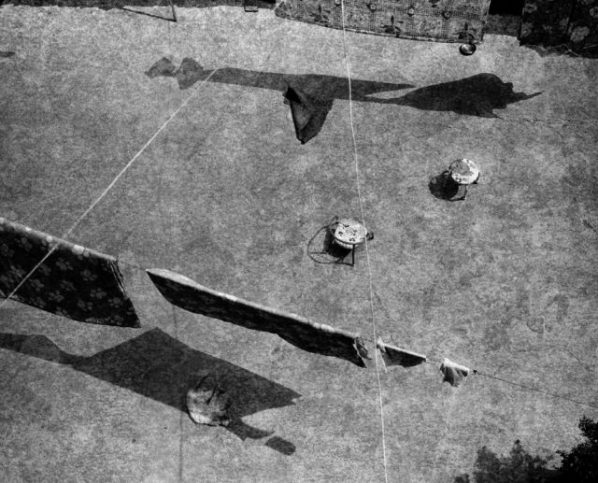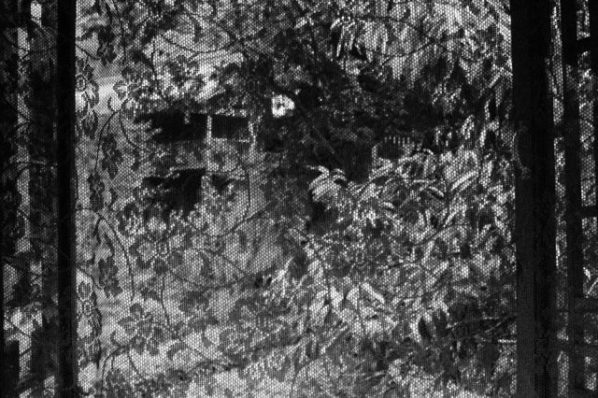
Luo Yongjin, Laundry, 2012
Insight and Mindfulness
By Chen Haiyan
There is fantastic serenity in Luo Yongjin’s works, not only in his photographs which are still. Even in his juxtaposed videos with ever-shifting focuses, such serenity still flows like quicksand in gentle night breeze.
I would distinguish such “serenity” from “silence”, which is the word I used to describe the works of Christopher Taylor, a British photographer and also a good friend of Luo Yongjin (I have deep love for the works by both of them and cannot help but “guanzhao [observing and comparing]” their works because they took part in a residency program in Guizhou together). Indeed, I appreciate the silence and the beauty of peaceful solitude. Cognitively I'd lean toward Luo Yongjin’s works, which might have something to do with my cultural preference as a native Chinese. The artist, as I recognize from his works, actively engages his mind in the complicated dynamics and constructs equilibrium of all powers. Do not mistake me for being nationalistic or judgmental. I see no hierarchy standard in art, and those who emphasize in it are merely grandstanding. The inspirational power of art is highly personal, for what matters is whether “He” speaks to your mind or body. Standing on the scorching land of China, I am deeply aware of how precious the hard-won equilibrium is, not taking into account the difficult position of photography, especially black and white photography.

Luo Yongjin, Curtain, Emeishan, 2015
It was a noteworthy coincidence that I was on a trip when I wrote the article for Luo Yongjin’s exhibition "Heart Steps”, so both the exhibition and the article could be considered as some sort of “travel notes”. This time, I’m writing on a vacation in the quiet deep mountains. The tranquil mountain scene at night sets off the serenity in the photos, however, still can be heard are sporadic sounds from the buzzing insects, the rustling tree leaves, a random barking dog, and an untimely crowing rooster… This is a great metaphor for the “serenity” in Luo Yongjin’s works. It is a state of dynamic balance and of being at the right place on a spectrum. Things are not quite so simple always as black and white. Pure black and white stand out only when various shades of grey are coordinated. This is how nature runs its course. Overemphasizing on the black or white could be poisonous or harmful. To tone down the mystery in my narrative, I’d like to differentiate my definitions of “silent” and “serene”. “Silent” describes a state within one's mind while “serene” describes a state of calmness facing the reality. Serenity comes from the mindfulness and acceptance of nature and oneself regardless of disturbing noises or time’s passing, which is how I feel as I’m writing this essay. This is not a textbook review, but rather a way to express my observations and interpretations with certain ideas as my clue. I use my words to reflect, while Luo Yongjin uses a visual “language” with his camera. This is one sort of “guanzhao [reflection]”. I won’t go into painful details of the literal meaning, usages, etymology, and connotations of the word “guanzhao”, but I’d like to point out its most profound and traditional meaning: insight into the true nature of reality and the mindfulness of oneself in the here and now.

Luo Yongjin, Official Paper, Gongyi, 2015
As a photographer mature in his artistic expression, Luo Yongjin has never lost track of the ability of such insight and mindfulness. He never rests on superfluous narration or aggressive persuasion. Patient and reserved, he draws his materials from real life experience and rises above it. He circles the world around him with his ephemeral lifetime as the radius and expresses what he feels in the circle and beyond. Therefore, Luo’s works often bring one’s attention to the flow of time, or to say, embody his own awareness of time. Indeed, time is the essence of photography and a “photographer" can only earn this name by capturing time well.
In addition, Luo Yongjin has a coherent style throughout his works of all themes, subjects, and ways of expression and display, a sign of his maturity. For most artists, a characteristic style could be fetters or even obstacles, but Luo managed to skillfully and constantly build on the powerful serenity with each of his new works. His sensitivity in observing reality, creativity in capturing things from the right angles, and the versatility to go between the lasting and the transient, the ordinary and the extraordinary can be translated into the wisdom of “guanzhao (vipassana)”. To abstract patterns and forms from observing the reality is what I deem as poeticization. To appreciate such animated works like his, the most straightforward way of simply viewing them might be more appropriate than over interpreting them and dogmatically dissect them. Sometimes, criticism is just a parasite sucking on a dead host.
To blend in such serenity, I’d like to say no more but to conclude by quoting Caigentan by Hong Yingming of the Ming Dynasty: ”Rich wine and meat, or anything that is particularly bitter or sweet, are not real delicacies; what is truly luscious is light and plain in taste. So, anything superhuman or extraordinary does not characterize a true man; on the contrary, he is so commonplace in his everyday life that he can scarcely be distinguished from ordinary people."
Written in the mountains
16 July, 2016
Translation: Chen Dan
About the exhibition
Dates: Sep 10, 2016 – Oct 21, 2016
Opening: Sep 10, 16:00
Venue: OFOTO Gallery
Courtesy of the artist and OFOTO Gallery.




























